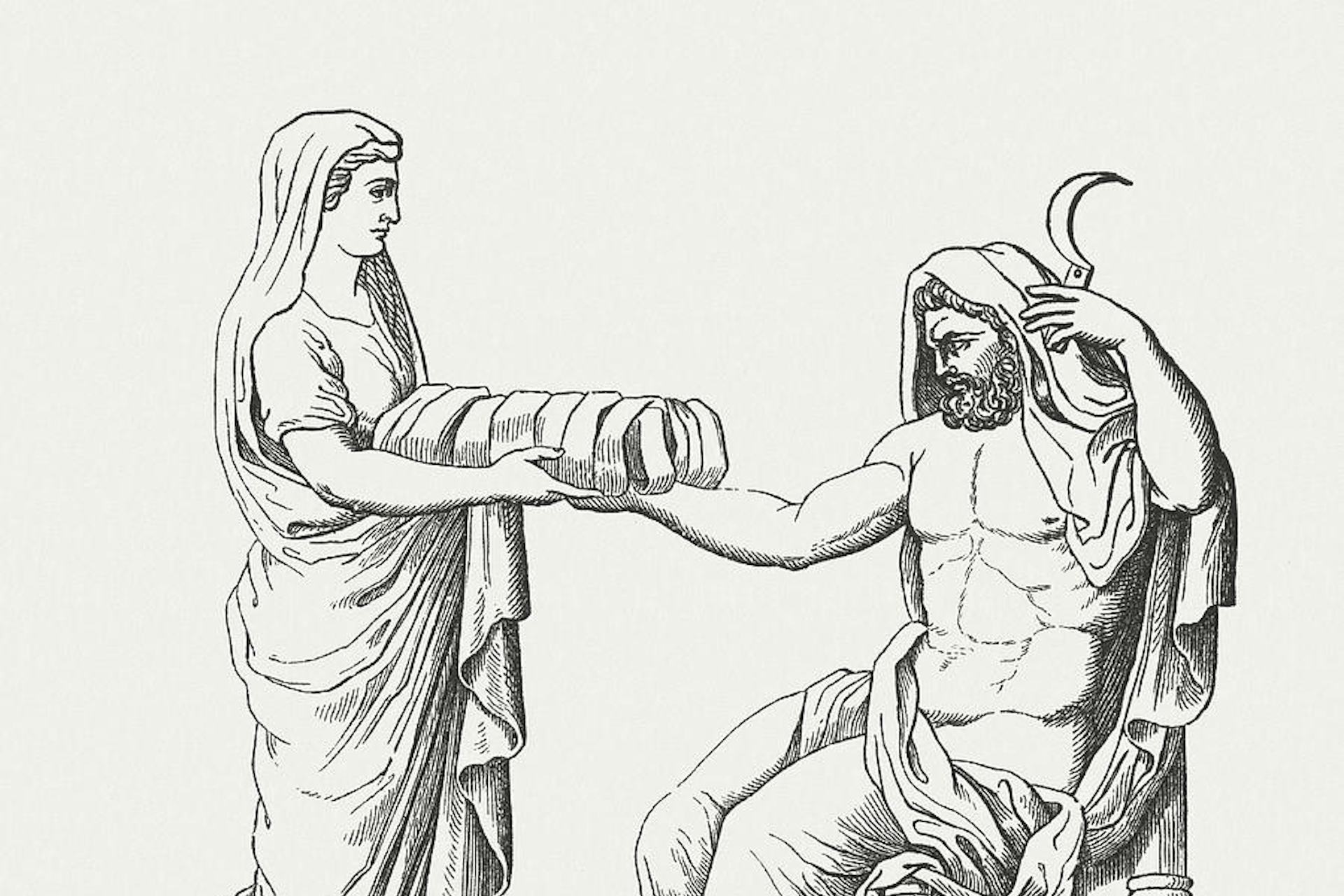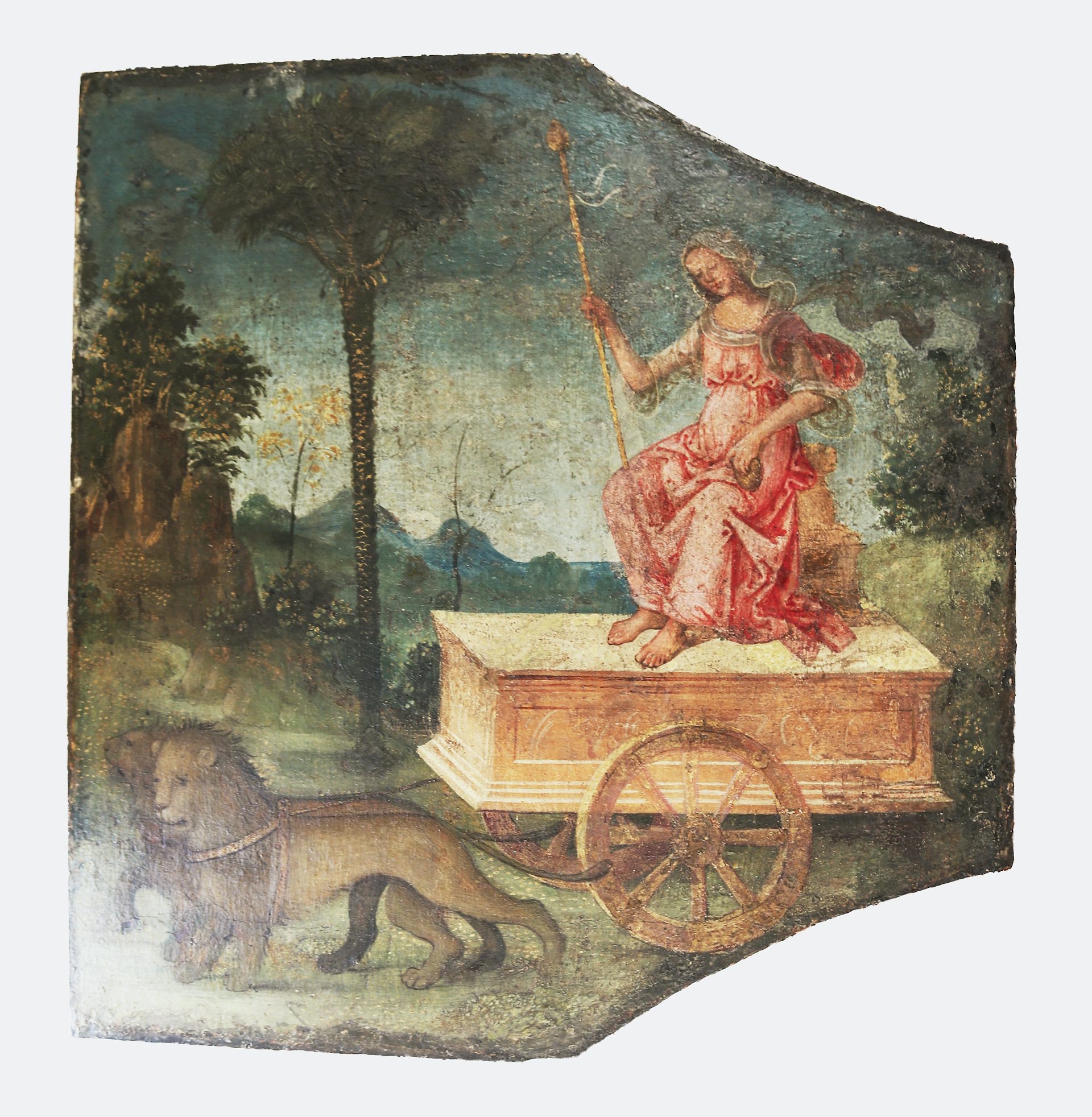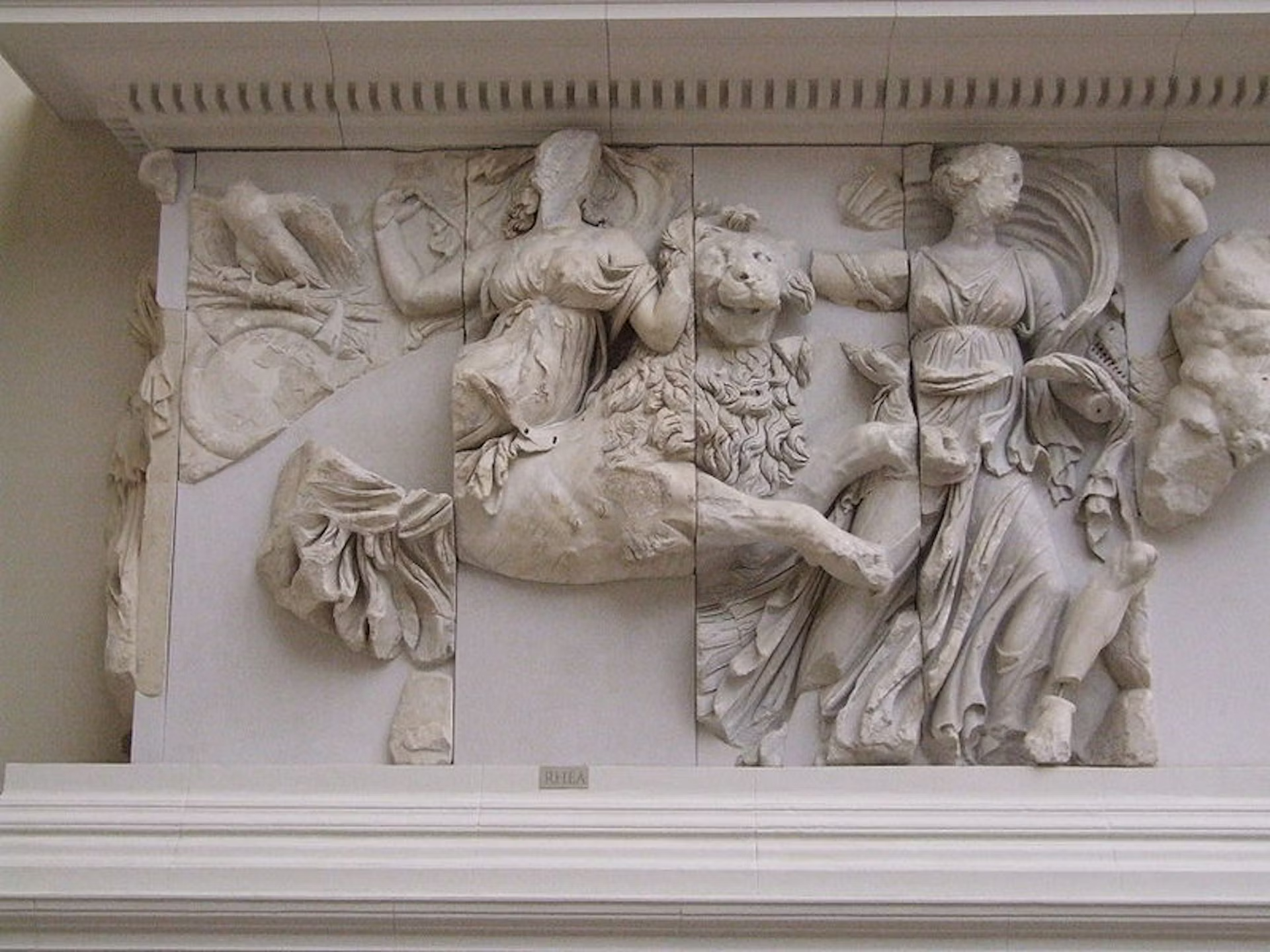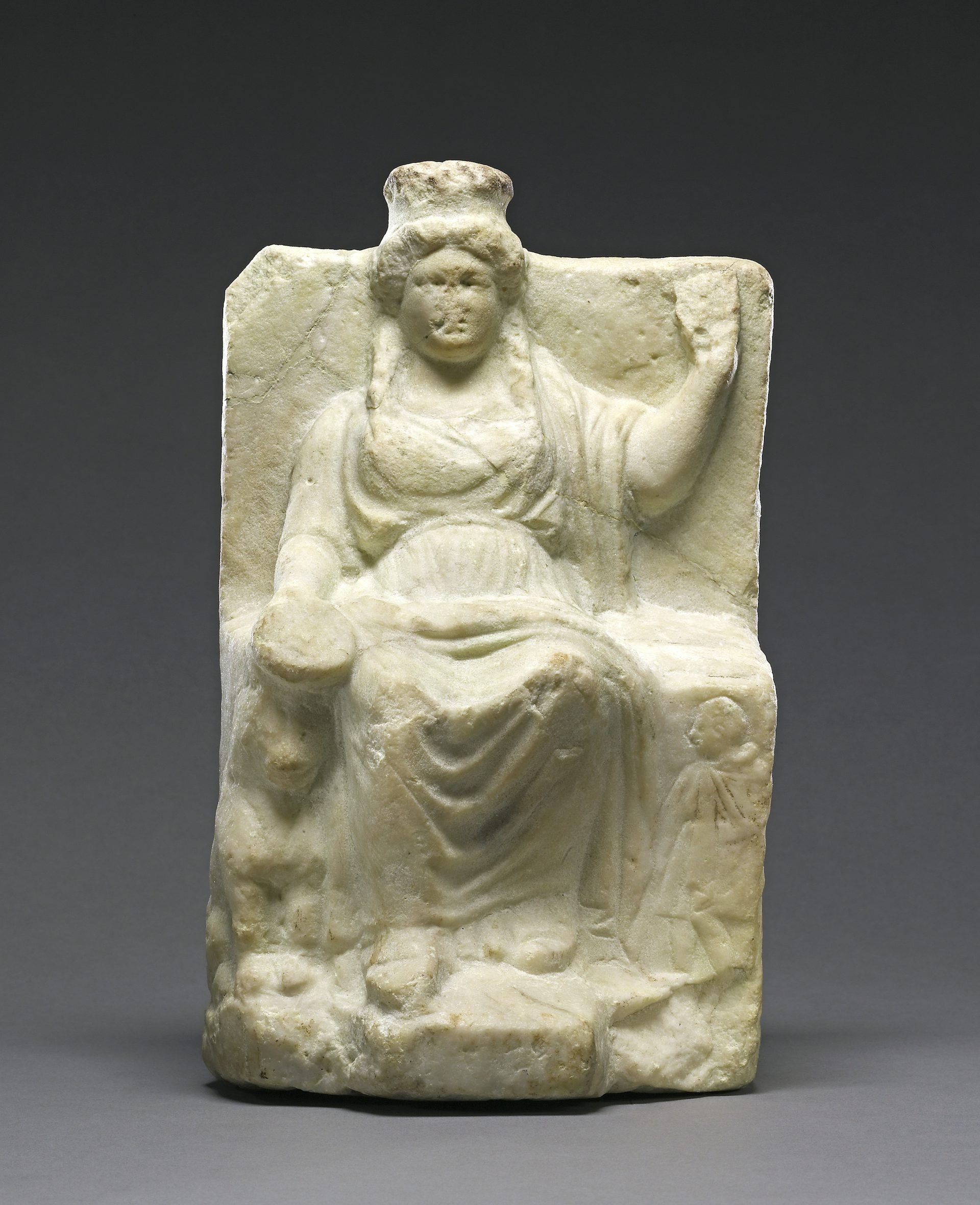Rhea

Rhea presents Cronus the stone wrapped in cloth, woodcut engraving from The Olympus or the Mythology of the Greeks and Romans by August Heinrich Petiscus (1878).
Wikimedia CommonsPublic DomainOverview
Rhea, the daughter of Gaia and Uranus, was a Greek Titan and the mother of the Olympians. Along with the other Titans, Rhea was imprisoned in Tartarus by her tyrannical father; she was eventually liberated by her brother Cronus, whom she married. Rhea gave birth to the Olympian deities and, through her cunning, helped them overthrow Cronus and establish a new cosmic order.
Hailed as “Mother of the Gods,” Rhea was revered across the Hellenic world. She was especially popular on the island of Crete, where the infant Zeus was said to have come of age. Rhea was also held in high regard by the Orphics, who believed that she had conceived the goddess Persephone with her son Zeus. In art and literature, she was often conflated with Cybele, an Anatolian mother goddess whose cult was imported to the Greek world in the fourth century BCE.
Etymology
A standard folk etymology of the name “Rhea” (Greek Ῥέα or Ῥεία, translit. Rhea or Rheia)—and the one endorsed by Plato in Cratylus—claimed that “Rhea” was a feminine form of the ancient Greek verb rheō, meaning “flow,” “discharge,” or “stream.”[1]
Modern scholars have also suggested possible connections with the Greek words rheia or rhea (“easily”), era (“earth”), and oros (“mountain”). Alternatively, Rhea’s name may be Semitic in origin, with possible connections to the root meaning “friend” (Ugaritic rᶜ, Hebrew rᶜh) or “graze” (Akkadian reɔu(m), Hebrew rᶜh).[2]
Pronunciation
English
Greek
Rhea Ῥέα or Ῥεία (translit. Rhea or Rheia) Phonetic
IPA
[REE-uh] /ˈri ə/
Epithets
Many of Rhea’s epithets and cult titles related to her maternal role, including mētēr (“mother”), mētēr theōn (“mother of the gods”), mētēr megalē (“great mother”), and mētēr oreiē (“mountain mother”). Other epithets, such as Dindymēnē, Sipylēnē, and Idaia, linked Rhea to sites that were sacred to her.
Other Names
There were several alternate forms of Rhea’s name in the ancient world, including Rheia, Rheē, and Rheiē. She was also frequently identified with the goddesses Cybele (or Cybebe), Agdistis, and Meter Theon (“Mother of the Gods”). The Romans called her Ops.
Attributes
Rhea was a mother goddess, beloved for her nurturing compassion. From relatively early on, she was closely identified with the Phrygian mother goddess Cybele; as a result, the attributes of the two goddesses became largely indistinguishable (indeed, for most of Greek and Roman history, Rhea and Cybele were regarded as one and the same).
Like Cybele, Rhea was generally represented as wearing a tall crown or veil and seated on a throne. Also like Cybele, Rhea held lions as sacred. She was often shown with lions sitting beside her throne or even riding a chariot pulled by lions. In Greece, the oak tree was also sacred to Rhea.

The Triumph of Cybele by Pinturicchio (ca. 1509). Depicted as Cybele, Rhea is shown in a cart pulled by a pair of lions.
The Metropolitan Museum of ArtPublic DomainAt the heart of Rhea’s (or Cybele’s) retinue were the Curetes of Corybantes, ecstatic priests who worshipped her with tambourines, cymbals, and drums. As Cybele, Rhea was also associated with Attis, an ill-fated youth sometimes represented as her consort, and the hermaphroditic Agdistis.
Family
Rhea was the daughter of Gaia, the primordial goddess of the Earth, and Uranus, the primordial god of the skies. Their union brought forth not only Rhea, but the other Titans as well: Oceanus, Coeus, Crius, Hyperion, Iapetus, Thea, Themis, Mnemosyne, Phoebe, Tethys and Cronus. Rhea’s other siblings included the Cyclopes (Brontes, Arges, and Steropes) and the Hecatoncheires (Kottos, Briareos and Gyges).[3]
Rhea married her younger brother Cronus, and together they had six children: Demeter, Hades, Hera, Hestia, Poseidon and Zeus.[4] By way of her children's extensive sexual liaisons, Rhea was grandmother to a significant portion of the Greek pantheon, including Ares, Hephaestus, Athena, Artemis, Apollo, Hermes, and Dionysus.
Family Tree
Mythology
Origins: Rhea, Mother of the Gods
According to Hesiod’s Theogony—the eighth-century BCE epic explaining the origins of the gods and the Greek cosmic order—Rhea was the daughter of Gaia (“Earth”) and Uranus (“Heaven”). She was one of the deities known as the Titans. But Uranus, the father of the Titans, was a mean and jealous god who imprisoned his children in the dim bowels of Tartarus so they could not usurp his dominion.
Uranus’ fears, as it turned out, were well founded: Cronus, the youngest of the Titans, eventually overthrew his father with the help of Gaia, severing the genitalia of the sky god and casting them into the sea. Cronus then became ruler not only of the Titans but of the whole cosmos.

Part of the Pergamum Altar, this frieze shows Rhea, whose face has been obliterated, riding a lion. Constructed in the early second century BCE at the direction of Eumenes II of Pergamum (in Asia Minor in modern Turkey). Pergamon Museum, Berlin, Germany.
Claus AbleiterCC BY-SA 3.0Cronus married his sister Rhea, and together they had many children. But the fears that had haunted his father also troubled Cronus. He became suspicious of his children and decided to swallow each of them as they emerged from the womb to prevent any rebellion. Hesiod writes that, when Rhea gave birth to Hestia, Demeter, Hera, Hades, and Poseidon,
[t]hese great Cronus swallowed as each came forth from the womb to his mother’s knees with this intent, that no other of the proud sons of Heaven should hold the kingly office amongst the deathless gods. For he learned from Earth and starry Heaven that he was destined to be overcome by his own son, strong though he was, through the contriving of great Zeus. Therefore he kept no blind outlook, but watched and swallowed down his children: and unceasing grief seized Rhea.[5]
Upon conceiving her sixth child, Zeus, Rhea hatched a scheme to spare the baby from Cronus’ jaws—and thereby save the others as well. When the agonies of childbirth seized her, Rhea sped towards Crete in the company of her mother, Gaia. Shortly after Zeus was born, Gaia whisked him to safety and raised him with all the care Mother Earth could provide. To complete her deception, Rhea offered Cronus a rock wrapped in the swaddling clothes of a newborn:
But to [Cronus] the mightily ruling son of Heaven, the earlier king of the gods, [Rhea] gave a great stone wrapped in swaddling clothes. Then he took it in his hands and thrust it down into his belly: wretch! he knew not in his heart that in place of the stone his son was left behind, unconquered and untroubled, and that he was soon to overcome him by force and might and drive him from his honours, himself to reign over the deathless gods.[6]
In time, Zeus matured to manhood and fulfilled his destiny, overthrowing Cronus and establishing a new world order on Mount Olympus.
Other Myths
The bulk of Rhea’s mythos involves her role as mother and savior of the Olympian gods. However, there were a handful of other myths about her.
In one version of the Greek cosmogony, the first rulers of the gods were Ophion and Eurynome, rather than Uranus and Gaia. They were eventually overpowered by Cronus and Rhea and cast into the waters of Oceanus.[7]
In another myth, Rhea found her husband Cronus being unfaithful to her with Philyra, one of the Oceanids. Caught red-handed, Cronus transformed himself into a horse and galloped away. Philyra, meanwhile, became the mother of the centaur Chiron.[8]
Rhea also played a role in the myths of the Olympians and is featured in two of the Homeric Hymns. According to the second Homeric Hymn (to Demeter), it was Rhea who persuaded the heartbroken Demeter to rejoin the company of the gods after her daughter Persephone was kidnapped by Hades.[9] In the third Homeric Hymn (to Apollo), Rhea is among the divine midwives of Leto when she gives birth to Apollo.[10]
Finally, there were some traditions in which Rhea was the one who taught Dionysus the rituals of his cult.[11]
Rhea and Cybele
By the fourth century BCE (if not earlier), Rhea was widely identified with the Phrygian mother goddess Cybele. Indeed, in Greek literature and cult, the names Rhea and Cybele were often used interchangeably. The strange mythology of Cybele can thus be added to the familiar early myths of the Titan Rhea.

Statuette of Cybele (ca. 300 BCE).
The J. Paul Getty MuseumPublic DomainCybele was sometimes said to have been born with both male and female genitalia, and to have been named Agdistis. But the gods feared Agdistis and cut off their male genitalia; now fully female, Agdistis became Cybele.[12]
At the heart of Cybele’s mythology is the tragic story of Attis. Sometimes said to have been born from the severed male genitalia of the hermaphroditic Agdistis (who was also Cybele), Attis was a beautiful young man from Phrygia. He caught the eye of the goddess Cybele, who fell in love with him. But Attis was untrue to Cybele and became engaged to a princess. Devastated and furious, Cybele drove Attis so mad that he ended up castrating himself. This myth was often used to explain why the devotees and priests of Cybele were eunuchs.
Worship
Rhea was worshipped widely throughout the ancient world under a variety of names.
There was an ancient Temple of Rhea in the city of Knossos on Crete.[13] Another early temple to the Titan, called the Metroum, was nestled in the courtyard of the giant Temple of Olympian Zeus in Athens.[14]
As Cybele, Rhea was worshipped throughout Asia, particularly in Asia Minor. She had major cults on Mount Sipylus, Mount Coddinus, and across the region of Phrygia, in what is now the northwestern coast of Turkey. There, Cybele had temples in the cities of Dindyma and Pessinus, where she was called Agdistis. It was said that the sacred image of Cybele/Agdistis/Rhea at Pessinus had fallen from heaven.
The worship of Cybele, or the “Great Mother,” eventually spread west into Italy. During the Second Punic War (218–201 BCE), the Romans brought the image of Cybele from Pessinus to Rome in a highly elaborate and dramatic ritual. They already worshipped the mother of Jupiter (the equivalent of Zeus) under the name Ops, and they seem to have identified Cybele with Ops, just as the Greeks identified her with Rhea.
The Romans built a temple in honor of the Great Mother/Cybele on the Palatine Hill at the heart of their city. Every year, they celebrated the goddess at the festival of the Megalesia.
Pop Culture
While references to Rhea are rare in popular culture, her name has appeared in a few non-mythical contexts. For example, the fifth moon orbiting the planet Saturn was named for her (a fitting choice, as Saturn itself was named after her father’s Roman analogue). First discovered by Italian astronomer Giovanni Domenico Cassini in 1672, the moon was initially called “Saturn V” and dedicated to King Louis XIV, Cassini’s French patron. The English astronomer John Herschel renamed it Rhea in 1847, ostensibly in order to maintain consistency with other planets bearing the names of Greek and Roman deities.
Rhea was also used to name a species of ratite (a group of large, long-legged, and flightless birds) native to South America and distantly related to both the emu and ostrich. Why the Titan’s name was bestowed upon this bird remains a mystery.